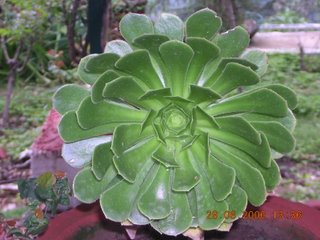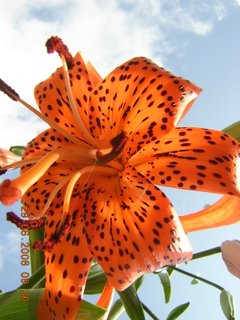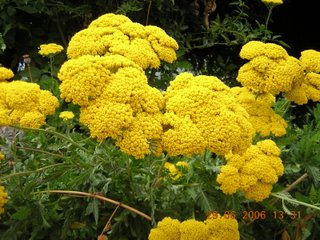But roses, for they are memories of lovers,
And lilies, their prayers,
Azaleas; who give themselves to the winds,
And irises, beloved of Pindar,
And the pale œnothera,
Incandescent in the twilight,
And many sweet and simple flowers—
Snowdrops and violets,
White and delicately veined—
And all shadowy wind-flowers.
But not tree blossoms,
Which are the breath of Spring,
Nor poppies, splendid and secret,
And sprung from drops of Persian blood,
Nor water-lilies, who have but their dreams,
And float, little worlds of scent and color,
Wrapt in their golden atmosphere.
~ Florence Taber Holt ~
 This is a picture of an aeonium. Since I am nt particularly knowledgeable about plant, I'm still undecided as to whether this is an "Aeonium undulatum" or an "Aeonium arboreum". The plant has succulent rosettes of waxy leaves, generally at the end of naked stems.
This is a picture of an aeonium. Since I am nt particularly knowledgeable about plant, I'm still undecided as to whether this is an "Aeonium undulatum" or an "Aeonium arboreum". The plant has succulent rosettes of waxy leaves, generally at the end of naked stems.
 Okay, I know this one - gladiolus!
Okay, I know this one - gladiolus!
Gladiolus is a genus of perennial flowering plants which belong to the iris family (Iridaceae). About 10 species are native to India. The long, sword-like leaves look particularly atractive.
 Tiger-lily. Also known as Columbia lily or lilium columbianum. What a stunning plant with its waxy orange leaves and dramatic black speckles!
Tiger-lily. Also known as Columbia lily or lilium columbianum. What a stunning plant with its waxy orange leaves and dramatic black speckles!
A school-going friend supplies the following information (TMI?):
Kingdom: Plantae -- Plants
Subkingdom: Tracheobionta -- Vascular plants
Superdivision: Spermatophyta -- Seed plants
Division: Magnoliophyta -- Flowering plants
Class: Liliopsida -- Monocotyledons
Subclass: Liliidae
Order: Liliales
Family: Liliaceae -- Lily family
Genus: Lilium -- lily
Species: lilium columbianum
 Iberis - Candytuft. This perennial comes into bloom the last part of April and lasts through June in Shimla. In fact, this plant I have photographed was the last of a straggling group. I love its evergreen foliage (not visible here) as it provides a lovely dark backdrop to these delicate flowers. Kungfoo_Kitty helpfully adds here that it also has wonderful medicinal properties.
Iberis - Candytuft. This perennial comes into bloom the last part of April and lasts through June in Shimla. In fact, this plant I have photographed was the last of a straggling group. I love its evergreen foliage (not visible here) as it provides a lovely dark backdrop to these delicate flowers. Kungfoo_Kitty helpfully adds here that it also has wonderful medicinal properties.  Foxglove is the common name for plants of the Digitalis species. These plants, biennial or perennial, are native to the Mediterranean region, and can reach heights of 1.2 to 2 meters. The primary value of foxglove is medicinal - digitalis, a cardiovascular drug extracted from the leaves, is the most effective drug available for heart failure caused by hypertension or arteriosclerosis.
Foxglove is the common name for plants of the Digitalis species. These plants, biennial or perennial, are native to the Mediterranean region, and can reach heights of 1.2 to 2 meters. The primary value of foxglove is medicinal - digitalis, a cardiovascular drug extracted from the leaves, is the most effective drug available for heart failure caused by hypertension or arteriosclerosis.










No comments:
Post a Comment